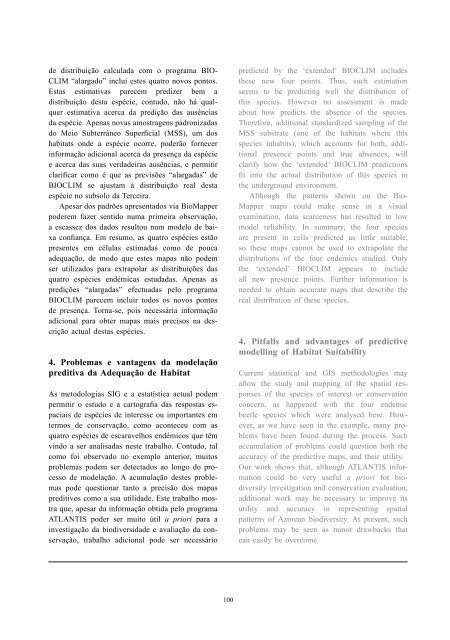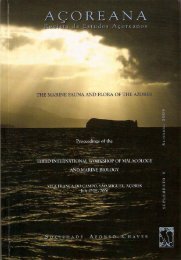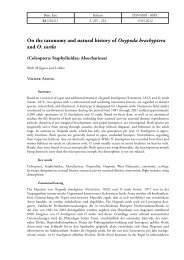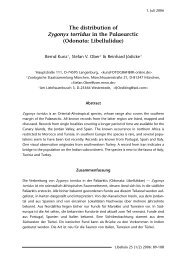(eds.) (2005). - Portal da Biodiversidade dos Açores - Universidade ...
(eds.) (2005). - Portal da Biodiversidade dos Açores - Universidade ...
(eds.) (2005). - Portal da Biodiversidade dos Açores - Universidade ...
Create successful ePaper yourself
Turn your PDF publications into a flip-book with our unique Google optimized e-Paper software.
de distribuição calcula<strong>da</strong> com o programa BIO-<br />
CLIM “alargado” inclui estes quatro novos pontos.<br />
Estas estimativas parecem predizer bem a<br />
distribuição desta espécie, contudo, não há qualquer<br />
estimativa acerca <strong>da</strong> predição <strong>da</strong>s ausências<br />
<strong>da</strong> espécie. Apenas novas amostragens padroniza<strong>da</strong>s<br />
do Meio Subterrâneo Superficial (MSS), um <strong>dos</strong><br />
habitats onde a espécie ocorre, poderão fornecer<br />
informação adicional acerca <strong>da</strong> presença <strong>da</strong> espécie<br />
e acerca <strong>da</strong>s suas ver<strong>da</strong>deiras ausências, e permitir<br />
clarificar como é que as previsões “alarga<strong>da</strong>s” de<br />
BIOCLIM se ajustam à distribuição real desta<br />
espécie no subsolo <strong>da</strong> Terceira.<br />
Apesar <strong>dos</strong> padrões apresenta<strong>dos</strong> via BioMapper<br />
poderem fazer sentido numa primeira observação,<br />
a escassez <strong>dos</strong> <strong>da</strong><strong>dos</strong> resultou num modelo de baixa<br />
confiança. Em resumo, as quatro espécies estão<br />
presentes em células estima<strong>da</strong>s como de pouca<br />
adequação, de modo que estes mapas não podem<br />
ser utiliza<strong>dos</strong> para extrapolar as distribuições <strong>da</strong>s<br />
quatro espécies endémicas estu<strong>da</strong><strong>da</strong>s. Apenas as<br />
predições “alarga<strong>da</strong>s” efectua<strong>da</strong>s pelo programa<br />
BIOCLIM parecem incluir to<strong>dos</strong> os novos pontos<br />
de presença. Torna-se, pois necessária informação<br />
adicional para obter mapas mais precisos na descrição<br />
actual destas espécies.<br />
4. Problemas e vantagens <strong>da</strong> modelação<br />
preditiva <strong>da</strong> Adequação de Habitat<br />
As metodologias SIG e a estatística actual podem<br />
permitir o estudo e a cartografia <strong>da</strong>s respostas espaciais<br />
de espécies de interesse ou importantes em<br />
termos de conservação, como aconteceu com as<br />
quatro espécies de escaravelhos endémicos que têm<br />
vindo a ser analisa<strong>da</strong>s neste trabalho. Contudo, tal<br />
como foi observado no exemplo anterior, muitos<br />
problemas podem ser detecta<strong>dos</strong> ao longo do processo<br />
de modelação. A acumulação destes problemas<br />
pode questionar tanto a precisão <strong>dos</strong> mapas<br />
preditivos como a sua utili<strong>da</strong>de. Este trabalho mostra<br />
que, apesar <strong>da</strong> informação obti<strong>da</strong> pelo programa<br />
ATLANTIS poder ser muito útil a priori para a<br />
investigação <strong>da</strong> biodiversi<strong>da</strong>de e avaliação <strong>da</strong> conservação,<br />
trabalho adicional pode ser necessário<br />
100<br />
predicted by the ‘extended’ BIOCLIM includes<br />
these new four points. Thus, such estimation<br />
seems to be predicting well the distribution of<br />
this species. However no assessment is made<br />
about how predicts the absence of the species.<br />
Therefore, additional stan<strong>da</strong>rdized sampling of the<br />
MSS substrate (one of the habitats where this<br />
species inhabits), which accounts for both, additional<br />
presence points and true absences, will<br />
clarify how the ‘extended’ BIOCLIM predictions<br />
fit into the actual distribution of this species in<br />
the underground environment.<br />
Although the patterns shown on the Bio-<br />
Mapper maps could make sense in a visual<br />
examination, <strong>da</strong>ta scarceness has resulted in low<br />
model reliability. In summary, the four species<br />
are present in cells predicted as little suitable,<br />
so these maps cannot be used to extrapolate the<br />
distributions of the four endemics studied. Only<br />
the ‘extended’ BIOCLIM appears to include<br />
all new presence points. Further information is<br />
needed to obtain accurate maps that describe the<br />
real distribution of these species.<br />
4. Pitfalls and advantages of predictive<br />
modelling of Habitat Suitability<br />
Current statistical and GIS methodologies may<br />
allow the study and mapping of the spatial responses<br />
of the species of interest or conservation<br />
concern, as happened with the four endemic<br />
beetle species which were analysed here. However,<br />
as we have seen in the example, many problems<br />
have been found during the process. Such<br />
accumulation of problems could question both the<br />
accuracy of the predictive maps, and their utility.<br />
Our work shows that, although ATLANTIS information<br />
could be very useful a priori for biodiversity<br />
investigation and conservation evaluation,<br />
additional work may be necessary to improve its<br />
utility and accuracy in representing spatial<br />
patterns of Azorean biodiversity. At present, such<br />
problems may be seen as minor drawbacks that<br />
can easily be overcome.

















